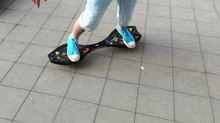Waveboard
A wave board is a skateboard- like fun sports device with which the driving behavior of a snowboard or a surfboard on asphalt is imitated to a certain extent . In English-speaking countries, these boards are called casterboard or caster board (from English caster or castor , castor wheel 'and board , board'). In Germany, the product name Waveboard ("wave board") has established itself . Waveboards are single-track and use two approximately 77 mm rubber rollers, similar to those used for inline skates . In contrast to these, the roles of Waveboards are softer in order to meet the special requirements for traction.
development
The first wave board was developed by a Korean designer and sold there under the name Casterboard from 2003. In 2004 these boards came onto the US market and were first presented in Germany at ISPO SPORT & STYLE 2007 in Munich under the name Waveboard . Since then, the wave board has enjoyed increasing popularity and is now offered by many manufacturers and importers in various qualities, techniques and price ranges.
Two world-famous brands are The Wave and RipStik . Both devices are based on the same patent. They differ in a few details such as the width of the base plates, length and design of the torsion bar as well as the design of the rollers and the angle of inclination of their axes of rotation. Supporters of the respective boards say that one person has better handling characteristics and the other has higher potential for tricks.
construction
Instead of a continuous deck as in skateboards, two plastic footplates are used, which are connected by a short torsion bar that allows the footplates to rotate slightly in opposite directions around the longitudinal axis. A roller is attached under each base plate, which can be freely or to a limited extent pivoted depending on the model.
- Streetsurfing waveboard
With the wave board from Street Surfing , both rollers can be swiveled through 360 °, their swivel axes are inclined by about 30 ° from the vertical. This gives the roles a preferred orientation, giving the board a clear front and back. This is offered in different designs, whereby the cover plates can also be exchanged. The board is around 85 cm long and weighs around 4.5 kg. Street Surfing has expanded its product range over the past few years.
- RipStik
The RipStik from Razor differs mainly in shape and caster system from The Wave . The Ripstik Classic is mainly popular in countries outside Europe. With the RipStik Air , Razor has also made a breakthrough in Europe. In this model, the torsion bar was omitted and the cover plate was cast in one piece. In contrast to The Wave, the wheels of the RipStik Air are provided with springs and cannot be rotated through 360 °, but only through 90 °. This makes the RipStik Air easier to drive and particularly suitable for inexperienced drivers.
- Other models
In addition to the above-mentioned world-famous brands, there are other models from various manufacturers and importers. The Z. B. TimberWolf ConVert , currently only available in the USA, differs from the other models primarily in the caster system. The rollers can be swiveled and tilted freely, so that the board can move in both directions. The boards are also made of maple wood. There are now "split" wave boards that can be driven like a normal wave board.
- Wavescooter
Wavescooters are a combination of kick scooters and wave boards and should allow other acrobatic tricks to be performed by the additional grip on the handlebars. However, this system is only a weak compromise between the two types of sports equipment. In other words , you can neither ride a wave board nor a scooter with a wave scooter. Again, there are different techniques and even more numerous manufacturers.
Drive
Due to the castor structure, the wave board can be moved forwards, sideways and at an angle, but not backwards. The TimberWolf is an exception . The single-lane allows fast straight-ahead driving, wide curves and tight pans, for example when braking. Sloping drifting or spinning is also possible. It is also suitable for the halfpipe and numerous skateboard tricks . In order to gain momentum on a flat surface, it is not necessary to push off the ground; rather, corresponding leg or hip movements generate an independent acceleration of the board. So even gradients can be mastered.
Unlike the similarly structured freeboard or snakeboard variants , there are no bindings, so that unhindered jumping is possible. The wave board then does not run away on inclines, but immediately tips over on its side and comes to a standstill after a short slide at most.
Web links
Individual evidence
- Kirsten Boldt: Wavers set the pace from the hip . In: Kölner Stadt-Anzeiger (Cologne, March 8, 2008).


